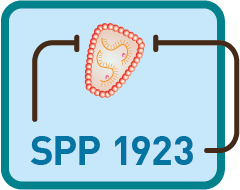Transcriptional regulation of innate immunity – interplay of exogenous and endogenous retroviruses

Project Member

Prof. Dr. Daniel Sauter
Project Leader
Prof. Dr. Daniel Sauter
Phone: +49 7071 29 – 80177
Fax: +49 7071 29 – 5790
Daniel.Sauter@med.uni-tuebingen.de
Institute for Medical Virology
and Epidemiology of Viral Diseases
University Hospital Tübingen
Elfriede-Aulhorn-Straße 6
72076 Tübingen
Germany

Smitha Badarinarayan,
PhD Student
Project Summary
Viruses hijack a plethora of host factors to ensure efficient viral replication. For example, HIV1 and related lentiviruses exploit cellular transcription factors such as NF-κB for the expression of their own genes. These transcription factors are frequently activated upon infection and mediate the expression of several antiviral and pro-inflammatory host factors. Since chronic inflammation drives disease progression in HIV-infected individuals, a better understanding of transcription factor activation will provide important insights into retroviral pathogenicity. Notably, transcription factor activation is also an important determinant of viral latency, which represents a major obstacle in curing HIV/AIDS.
Within the first funding period of this SPP, we showed that primate lentiviruses evolved several independent mechanisms to interfere with transcription factor activation. For example, we demonstrate that the viral protein U (Vpu) of HIV‑1 is a potent inhibitor of NF-κB-elicited immune responses, suppressing the transcription of multiple restriction factors and pro-inflammatory cytokines (Langer et al., 2019, eLife; Hotter et al., 2017, PLoS Pathogens). Studies in humanized mice confirmed that this immuno-suppressive activity is relevant for retroviral replication in vivo (Yamada et al., 2018, Cell Host and Microbe). Furthermore, we uncovered a temporal regulation of NF-κB activation enabling efficient initiation of viral gene expression early upon infection, while limiting antiviral immune responses during later stages of the replication cycle (Hotter et al., 2017, PLoS Pathogens; Sauter et al., 2015, Cell Reports).
Intriguingly, binding sites for pro-inflammatory transcription factors such as IRFs and STATs are often retained in LTR promoters of endogenous retroviruses (ERVs). Accumulating evidence suggests that these LTRs are in turn exploited by the host to regulate the expression of antiviral genes. In the second funding period, we will therefore elucidate the role of ERVs in inducing innate immune responses and limiting retroviral replication. Our transcriptome analyses revealed that specific ERV families (e.g. LTR12C) are activated in HIV‑1 infected primary T cells. Interestingly, LTR12C promoter elements have been shown to bind IRFs and STATs, and may determine the expression and IFN-inducibility of antiretroviral factors such as GBP2 and GBP5 (Braun et al., 2019, Cell Reports). We will combine in vitro and in vivo transcriptomics and proteomics approaches to monitor the induction of endogenous retroelements in HIV‑1 infected cells in an unbiased manner. Furthermore, collaborative in silico analyses will complement LTR reporter assays and mutational analyses to identify the mechanisms that underlie the activation of retroelements upon HIV‑1 infection. Finally, we aim to identify cellular antiviral genes that are regulated by endogenous LTRs and to decipher the role of LTR12C elements and other ERV lineages in restricting retroviral replication.
The results will help to understand a sophisticated host-virus arms race, in which host cells exploit the ability of endogenous retroviral promoters to hijack cellular transcription factors.


